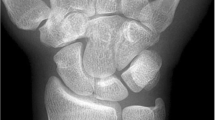Abstract
Based on the presence of a facet for the hamate two types of lunate bone have been described in the wrist; type I is without a facet for the hamate while type II bears a facet on the medial surface for articulation with the proximal pole of the hamate. Compared to type I lunates, type II lunates have been shown to have different kinematics, are more prone to clinically relevant degenerative changes in the hamato-lunate joint and may cause ulnar-sided wrist pain. The incidence of type II lunates seems to vary in different populations. Postero-anterior (PA) view of plain radiographs of the hand was studied in Arab subjects from Bahrain (n=381; 307 males and 74 females) to determine the incidence of type I and type II lunates. The mean age of the subjects was 31.1 years, the range being 18–80 years. In the population studied, only 148 (38.8%) of the 381 wrists showed type II lunate; 121 (31.7%) were found in males and 27 (7.1%) in females. There was no significant difference in the mean age of subjects with type I or type II lunates (P=0.16). There was no correlation between side and gender with the presence or absence of a hamate facet on the lunate. The incidence of type II lunate was much lower than reports in the literature of populations from the Western world, which could be attributed to a genetic variation in the Arab population in Bahrain. These data indicate that osteoarthritis of the hamate or lunate is less likely to be a cause of ulnar-sided wrist pain in Bahraini Arabs.


Similar content being viewed by others
References
Arai T (1993) Roentgenographical and anatomical study of the midcarpal joint—morphology and degenerative change of ulnar side (Original in Japanese). Nippon Seikeigeka Gakkai Zasshi 67:1114–1121
Aufauvre B, Herzberg G, Garret J, Berthonneaud E, Dimnet J (1999) A new radiographic method for evaluation of the position of the carpus in the coronal plane: results in normal subjects. Surg Radiol Anat 21(6):383–385
Burgess R (1990) Anatomic variation of the midcarpal joint. J Hand Surg [Am] 15A:129–131
Dautel G, Merle M (1997) Chondral lesions of the midcarpal joint. Arthroscopy 13(1):97–102
Dharap AS, Lutfi I, Abu-Hijleh MF (2005) Population variation in the incidence of the medial (hamate) facet of the carpal bone lunate. Anthrop Anz (in press)
Malik AM, Schweitzer ME, Culp RW, Osterman LA, Manton G (1999) MR imaging of the type II lunate bone: frequency, extent, and associated findings. Am J Roentgenol 173(2):335–338
Nakamura K, Beppu M, Patterson RM, Hanson CA, Hume PJ, Viegas SF (2000) Motion analysis in two dimensions of radial-ulnar deviation of type I versus type II lunates. J Hand Surg [Am] 25(5):877–888
Nakamura K, Patterson RM, Moritomo H, Viegas SF (2001) Type I versus type II lunates: ligament anatomy and presence of arthrosis. J Hand Surg [Am] 26A:428–436
O’Rahilly R (1953) Survey of carpal and tarsal anomalies. J Bone Joint Surg 35A:626–642
Pfirrmann CW, Theumann NH, Chung CB, Trudell DJ, Resnick D (2002) The hamatolunate facet: characterization and association with cartilage lesions—magnetic resonance arthrography and anatomic correlation in cadaveric wrists. Skeletal Radiol 31(8):451–456
Sagerman S, Hauck R, Palmer A (1995) Lunate morphology: can it be predicted with routine X-ray film? J Hand Surg [Am] 20A:38–41
Thurston A, Stanley K (2000) Hamato-lunate impingement: an uncommon cause of ulnar-sided wrist pain. Arthroscopy 16(5):540–544
Viegas S (1990) The lunatohamate articulation of the midcarpal joint. J Arthrosc Rel Surg 6:5–10
Viegas SF, Wagner K, Patterson R, Peterson P (1990) Medial (hamate) facet of the lunate. J Hand Surg [Am] 15A:564–570
Viegas S, Patterson R, Hokanson J, Davis J (1993) Wrist anatomy: incidence, distribution, and correlation of anatomic variations, tears, and arthrosis. J Hand Surg [Am] 18A:463–475
Williams PL, Bannister LH, Berry MM, Collins P, Dyson M, Dussek JE, Ferguson MWJ (eds) (1995) Osteology. In: Gray’s Anatomy, 38th edn. Churchill Livingstone, Edinburgh, pp 648–649
Acknowledgments
The authors are grateful to Professor Hossam Hamdy for his valuable help and advice. Thanks to Dr. A. H. Al-Awadhi, Chairperson, and to the technical staff of the Radiology Department, Salmaniya Medical Complex for their kind assistance. Thanks to Mohamed Ghali Rashid, Reference and Serials Librarian, Arabian Gulf University for his help.
Author information
Authors and Affiliations
Corresponding author
Rights and permissions
About this article
Cite this article
Dharap, A.S., Al-Hashimi, H., Kassab, S. et al. The hamate facet of the lunate: a radiographic study in an Arab population from Bahrain. Surg Radiol Anat 28, 185–188 (2006). https://doi.org/10.1007/s00276-005-0061-0
Received:
Accepted:
Published:
Issue Date:
DOI: https://doi.org/10.1007/s00276-005-0061-0



